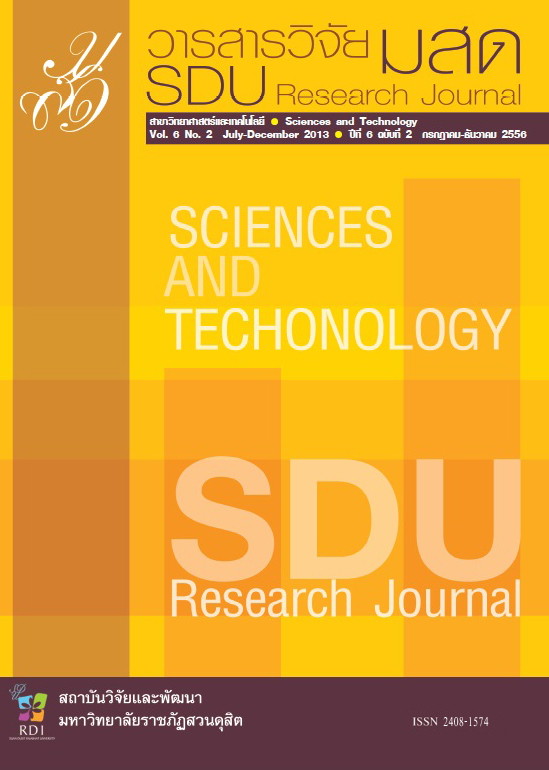ปัจจัยที่สัมพันธ์กับอาการปวดข้อมือในเจ้าหน้าที่เคลื่อนย้ายผู้ป่วย
Keywords:
อาการปวดข้อมือ, เจ้าหน้าที่เคลื่อนย้ายผู้ป่วย, ท่าทางการทำงานAbstract
บทคัดย่อ
การวิจัยพรรณนาเชิงวิเคราะห์นี้มีวัตถุประสงค์เพื่อศึกษา อัตราชุกของการปวดข้อมือในเจ้าหน้าที่เคลื่อนย้ายผู้ป่วย และความสัมพันธ์ของปัจจัยส่วนบุคคล ปัจจัยจากลักษณะงาน กับการปวดข้อมือ กลุ่มตัวอย่างเป็นเจ้าหน้าที่เคลื่อนย้ายผู้ป่วย จำนวน 160 คน รวบรวมข้อมูลโดยการให้ตอบแบบสอบถาม เกี่ยวกับลักษณะส่วนบุคคล ลักษณะการทำงาน และอาการปวดข้อมือจากการทำงาน วิเคราะห์ข้อมูลด้วย Chi-square test, Crude Odd Ratio, และ Multiple Logistic Regression Analysis ผลการวิจัยพบว่า เจ้าหน้าที่เคลื่อนย้ายผู้ป่วยร้อยละ 37.0 มีการปวดข้อมือในรอบหนึ่งปีที่ผ่านมา และปัจจัยที่มีความสัมพันธ์อย่างมีนัยสำคัญทางสถิติ กับอาการปวดข้อมือของเจ้าหน้าที่เคลื่อนย้ายผู้ป่วยคือ มีประวัติการเกิดอุบัติเหตุที่ข้อมือ (c2 6.032,p-value .014) ท่าทางการทำงาน (c2 6.505,p-value .011) และจำนวนวันทำงานต่อสัปดาห์ (c2 5.763,p-value .016) และปัจจัยที่มีอำนาจในการทำนายอาการปวดข้อมืออย่างมีนัยสำคัญคือปัจจัยที่มีอิทธิพลต่ออาการปวดข้อมือในเจ้าหน้าที่เคลื่อนย้ายผู้ป่วยคือ จำนวนวันทำงานต่อสัปดาห์ (OR 0.459, 95% CI 0.229-0.917) ท่าทางในการทำงาน (OR 0.371, 95% CI 0.184-0.752) และการมีประวัติอุบัติเหตุที่ข้อมือ(OR 0.362, 95% CI 0.175-0.749) โดยอธิบายได้ร้อยละ 11.4 จากผลการศึกษาเสนอแนะว่า ควรมีการเฝ้าระวังอาการปวดข้อมือในกลุ่มที่เคยมีประวัติการเกิดอุบัติเหตุที่ข้อมือ และควรมีแนวนโยบายเรื่องการกำหนดเวลาทำงานที่ไม่ควรเกิน 5 วันต่อสัปดาห์ และควรมีการเข้มงวดเกี่ยวกับท่าทางในการทำงานที่ถูกต้อง เพื่อเป็นการลดโอกาสเสี่ยงต่อการเกิดอาการปวดข้อมือจากการทำงานในเจ้าหน้าที่เคลื่อนย้ายผู้ป่วย
คำสำคัญ อาการปวดข้อมือ เจ้าหน้าที่เคลื่อนย้ายผู้ป่วย ท่าทางการทำงาน
Abstract
This analytical descriptive research aimed to examine the prevalence rate of wrist pain and the association of personal factors, job characteristics with wrist pain among patient transfer workers. The sample was 160 patient transfer workers. Data were collected by self-administered questionnaire and analyzed using chi-square, crude odd ratio, and multiple logistic regression analysis. The results showed that the prevalence of work related wrist pain among workers was 37.0 %.The significance factors associated with wrist pain of patient transfer worker were history of wrist injury (c2 6.032,p-value .014), working posture (c2 6.505,p-value .011), and number of working day per week (c2 5.763,p-value .016). The significance factors that cloud predicted wrist pain of patient transfer workers were number of working day per week (OR 0.459, 95% CI 0.229-0.917), working posture (OR 0.371, 95% CI 0.184-0.752), and history of wrist injury (OR 0.362, 95% CI 0.175-0.749). Allof the factors predicted at 11.4% of wrist pain among patient transfer workers.The finding suggested that there should be a surveillance system for monitor wrist pain problem among workers who had past history of wrist injury and should have policy for working day not longer than 5 day per week. Furthermore there should be education program for enhancing worker to perform the right working posture.
Keywords: wrist pain, patient transfer workers, working posture







